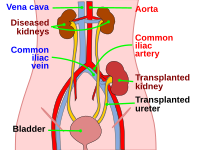
Photo from wikipedia
A 38-year-old man received a living donor kidney transplant with alemtuzumab induction immunosuppression and tacrolimus 1 mg-BID and MMF 250 mg-BID maintenance. Infection prophylaxis included valgancyclovir and trimethoprim/sulfamethoxazole. The patient… Click to show full abstract
A 38-year-old man received a living donor kidney transplant with alemtuzumab induction immunosuppression and tacrolimus 1 mg-BID and MMF 250 mg-BID maintenance. Infection prophylaxis included valgancyclovir and trimethoprim/sulfamethoxazole. The patient had excellent early allograft function (sCr 106 μ mol/L) but at 3 weeks sCr increased to 212 μ mol/L. A kidney biopsy showed acute interstitial nephritis and trimethoprim/sulfamethoxazole was discontinued and IV solumedrol and prednisone were administered. Three days later the patient presented with fevers but improved allograft function (sCr 168 μ mol/L). A chest CT showed bilateral pulmonary nodules suggesting multifocal infection. Workup including bronchoalveolar lavage was negative by histology and cultures. A repeat chest CT 10 days later showed progressive “ miliary ” disease. An open lung biopsy was performed showing granulomatous pneumonia with numerous Coccidioides spherules and endospores. A Coccidioides antibody CF test was positive (1:64 titre) and a bone marrow culture from weeks earlier ultimately grew Coccidiodes. Fluconazole (400 mg IV, 800 mg renal-dose equivalent) was initiated, MMF and empiric amphotericin-B discontinued, and tacrolimus prednisone maintenance immunosuppression adjusted. However, fevers continued and two weeks later the patient again had allograft dysfunction (sCr 230 μ mol/L). Another allograft biopsy was performed and showed granulomatous interstitial nephritis with Coccidioides fungi without rejection or significant chronic scarring (Figure 1). Fluconazole was increased (600 mg) and allograft function improved (sCr 133 μ mol/L). The patient was discharged 4 weeks after the initial tissue diagnosis and has stable allograft
Journal Title: Nephrology
Year Published: 2023
Link to full text (if available)
Share on Social Media: Sign Up to like & get
recommendations!